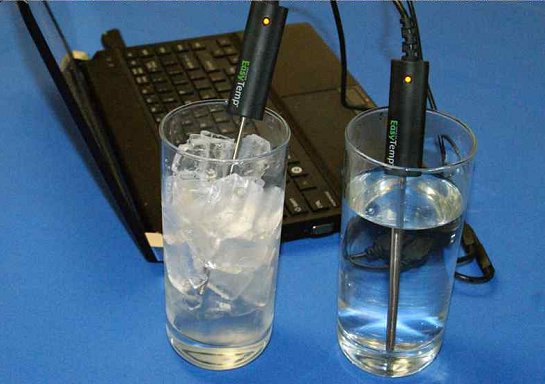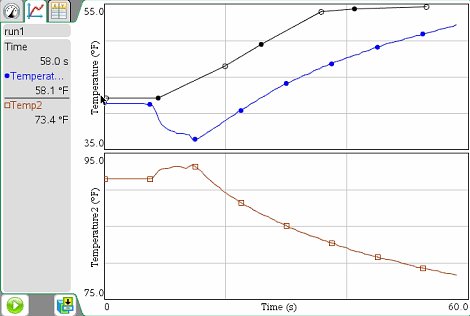By Tech Powered Dad | April 2, 2011

I recently had my second briefing about the TI-Nspire CX and Nspire OS 3.0 with Mark Fry, Texas Instruments’ product line strategy manager for the TI-Nspire. While my first briefing back in February focused on the announcement of the Nspire CX and the broad range of new capabilities coming to the Nspire line, this time Fry focused in on giving me an overview of the science capabilities of Nspire 3.0.
To catch anybody up who hasn’t been following the developments of the last couple of months, Texas Instruments has announced that a new TI-Nspire, the CX, will bring color to the Nspire for the first time as well as a new operating system that has a host of improvements, notably the ability to graph on photographs and 3D graphing. It was also mentioned that improved science capabilities would be coming to the Nspire in OS 3.0, primarily via Vernier Dataquest.
Fry’s demonstration of the TI-Nspire’s new science abilities was impressive. It’s a slick interface with loads of power. You don’t have to be a science teacher to appreciate what you can do with Nspire 3.0’s science tools. Let me review some of the highlights as well as some interesting insight Fry gave me into the ongoing Texas Instruments’ development of the Nspire.
TI-Nspire Lab Cradle and Vernier Hardware

If you’ve never used Vernier probes on a TI calculator before, you’ll need a quick explanation of what’s available. For over a decade, it’s been possible to plug in scientific data collection sensors such as motion detectors, thermometers, heart rate monitors, and many more into Texas Instruments calculators. This gives teachers and students the ability to use the calculator as a data collection device. The motion detector, or Calculator Based Ranger (CBR), has been a personal favorite of mine because it allows students to model distance vs. time graphs in real time.
The TI-Nspire has been capable of using Vernier scientific data collection sensors for some time via its USB port. However, when a TI-Nspire running 3.0 is fitted with the new TI-Nspire Lab Cradle, it’s capable of using multiple sensors simultaneously. Fry’s demonstration showed the ability to use two different thermometers, one that started in ice water and another in hot water, to show how they thermometers would return to room temperature. The cradle has five ports, 3 analog and 2 USB. The new cradle also allows the Nspire to use what Fry called, “high data capture” sensors, such as a sound sensor.
There are over 50 Vernier sensors available, and rather than list them all here, you’d be far better off to check out the complete list of Vernier sensors at TI’s site.
Vernier Dataquest App and Software
Of course, all of the sensors in the world aren’t going to do a bit of good if you don’t have the software to back it up, and as usual, the Nspire delivers. The Dataquest App is very slick. To start, you’ve got the option to run the sensors on the Nspire handheld itself or the on a computer. As is always the case on TI-Nspire, there’s an emphasis on multiple representations and sharing data across those representations.
For example, the data from the temperature experiment with two thermometers was initially displayed in real time as a temperature vs. time graph. Fry easily switched over to table of all the values collected during the experiment, where it was possible to strike any data values desired to focus in a specific portion of the data and then hop back over to the graph. This feature is great if you’ve either got bad data at the beginning or end of an experiment (often the case when I first start measuring with a sensor) or if you just need to focus in on a specific part of the data (like a single bounce when doing a ball drop experiment). Since it’s all collected within a TI-Nspire document, it’s also possible to open these multiple representations on different windows within the document. That means, among other things, it’s easy enough to add notes to the data and graphs.
Doing Things the “TI-Nspire Way”

Fry also showed me a really zippy periodic table they’ve added. You can look at the periodic table in a traditional view and scroll around to get information on each individual element. More impressive, though, is the fact that this periodic table is also integrated across the Nspire’s multiple representations. That means you can do a scatter plot with respect to the elements atomic mass, protons, or even their discovery year.
If you’ve got significant experience with the TI-84, you’ll recognize this as another feature that was a popular app with the 84 but noticeably absent when the TI-Nspire was originally launched a few years ago. This continues what has started to feel like a bit of a trend. A couple of releases ago, the Nspire added a polynomial root finder and simultaneous equations solver, giving it a better version of the 84’s app for the same purpose (PLYSMLT2). I asked Fry if there’s been a systematic effort by his TI-Nspire team to add some of the popular TI-84 features to the Nspire. Here’s his response:
"The 84 platform came from the 83 plus platform, which came from the 86 platform, so there's been a long history of building up a repertoire of all these different (features) you mentioned. TI-Nspire really is a departure from that in that we wanted to start with a clean state, on the one hand, so we have the documents, and the way the dynamic math–integrated graphs, geometry, data and statistics, and so forth. So we started fresh from that standpoint. But really we took all of the learning that we had from the former platform to apply it to this. But we didn't want to just port it over. We had to really understand the value and how these things needed to be integrated in a TI-Nspire way.
So I'm glad you say better, but we really worked hard on trying out how to make this really part of this environment and not just ported over and sort of stuck in there. These are things we've learned from the market over time and just because we made this jump over to TI-Nspire doesn't mean they're not important any more. The TI-83 plus is a great model for the things that teachers wanted and asked for over time. So (adding those features) is purposeful. But at the same time, we want to make it a better environment, a unique environment, that moves the math education in this technology forward."
It’ll be interesting to see what additions come to the Nspire over the next few OS upgrades. I had a wish list for features when it was first released (including conic section functionality, polynomial/simultaneous equation solver, 3D graphing), and that list seems to be shrinking with each new version of the OS. The TI-Nspire has been on the market for only a few years, and we’ve already seen massive changes in the user interface and capabilities, unlike the changes in any other graphing calculator to this point.
The changes have been fast and furious, and you’d have to think there will come a settling down period with the changes at some point. Frankly, I had sort of figured 2.0 was that point, and look what’s happened since. With the tremendous flexibility for changes that Texas Instruments has built into the Nspire platform, we may find that there continue to be some more significant improvements as TI continues to figure out how to do things in a “TI-Nspire way.”

